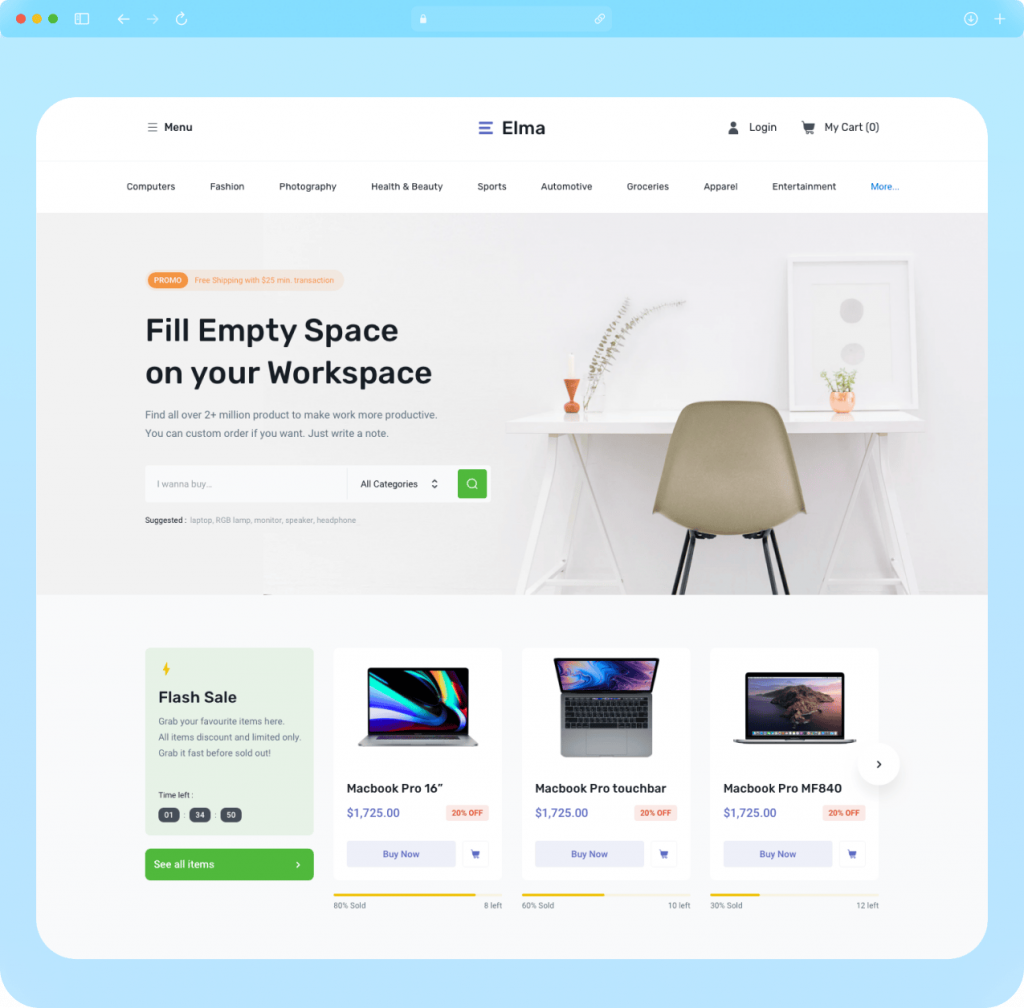- HOME
- -
- Services
- -
- eCommerce SEO
Website Design For Small Companies

Effective Website Design For Small Companies
Having great SEO is one thing, but there’s no point having lots of traffic if it doesn’t convert! We’re able to create a full basic website using pre-existing templates from Theme Forest and fully customise them to your brand and business needs! As we’re using pre-existing templates, this service is considerably cheaper and faster than most web design agencies. In fact, this website was created in that exact same manner. Contact us and let’s get your business up and running!
Why Does Your Business Need a Website?
- 24/7 Accessibility and Lead Generation: A website functions 24/7 allowing customers to interact with your business anytime, increasing revenue opportunities outside of the normal working hours.
- Information Hub for Customers: Efficiently communicate to clients the details of your services and products.
- Global Reach and Reputation Management: Share your company’s ethos, success stories, and customer testimonials, increasing your reputation locally and globally.
- Customer Research: Through tracking data and analytics you can learn more about our customers so you can better serve them.
- Cost-effective Marketing: Reach a wide audience in a cost-effective way. Your website is owned by you, and not a massive company like Google, Facebook, Yell or Checkatrade.
The Benefits of Website Design For Small Companies
The Finer Details
Crafting a website design tailored for small companies goes beyond mere aesthetics. It demands strategies deeply embedded in understanding the nuances and unique challenges these enterprises face.
Understanding Business DNA: Foundation of a Custom Strategy
A small business isn’t a scaled-down version of a large corporation. It has its pulse, values, and audience. To devise an effective website design, understanding this DNA is paramount.
Deep Dive into Company Ethos:
- Unravelling the core values, mission, and vision.
- Aligning the website’s voice with the brand’s personality.
Target Audience Analysis:
- Gaining insights into their preferences, behaviours, and pain points.
- Curating a user experience tailored to meet their expectations and needs.
Mobile-First Approach: Catering to the Growing Mobile Audience
Mobile users often dominate web traffic in today’s digital realm, and small businesses must prioritise this segment to remain competitive.
Responsive Design Principles:
- Ensuring seamless navigation across devices of varying screen sizes.
- Enhancing loading speeds and interactive features for mobile users.
Touch-Friendly Navigation:
- Intuitive touch controls for a smooth mobile browsing experience.
- Prioritising essential information for smaller screens to optimise user experience.
Incorporation of Local SEO: Attracting Nearby Potential Clients
For many small companies, local clientele forms the backbone of their business. Thus, a website optimised for local SEO becomes a strategic asset.
Geotagged Content:
- We are incorporating location-specific keywords and content.
- Enhancing visibility on local search queries.
Integration with Google My Business:
- Ensuring the business appears on local maps and search results.
- Facilitating easy reviews, ratings, and directions for potential customers.
PRICING PLANS
Website Design For Small Companies
Lite
Designed for small businesses and SMEs, eager to climb search rankings, enhance online exposure, and ignite organic growth.
- Full website
- CRO (conversion Rate Optimisation)
Medium
Crafted for medium-sized businesses seeking to elevate search rankings, boost online visibility, and drive organic growth.
- Full Website
- CRO (Conversion Rate Optimisation)
- + 10 SEO landing pages
Expert
Tailored for corporations to dominate search rankings, amplify online presence, and boost organic growth.
- Full Website
- CRO (Conversion Rate Optimisation)
- +25 SEO Landing pages
Extras
- Website Hosting (with email & setup)
- Domain Registration (yes, choosing the right name can help with rankings!)
- WooCommerce Integration
what we do
Content to Boost EAT Scores

Establishing a brand’s credibility goes far beyond offering quality products or services in the digital landscape. The EAT score, an essential component in Google’s ranking algorithm, has amplified the importance of showcasing expertise, authority, and trustworthiness through online content and design.
Expertise:
- We are highlighting qualifications, experiences, and credentials.
- Showcasing case studies, testimonials, and endorsements.
Authoritativeness:
- We are demonstrating thought leadership through articles, blogs, and guest posts.
- We are earning backlinks from reputable sources and industry leaders.
Trustworthiness:
- We are providing precise contact details, transparent policies, and security certifications.
- We are building a consistent online narrative across all platforms.
Web Design Elements to Showcase Expertise and Trust
An intuitive web design is instrumental in guiding the visitor to recognise and appreciate a brand’s EAT elements.
Testimonial and Review Sections:
- Incorporating genuine feedback from clients or customers.
- Displaying third-party review badges or ratings.
Certifications and Accreditations:
- Strategically placing logos or badges of professional affiliations.
- Highlighting industry-specific training or recognition.
Precise Navigation and User Experience:
- Crafting an easy-to-navigate site structure.
- Ensuring responsiveness across devices to cater to all user types.

Aligning Design and Information for Authority
While design guides the eye, content remains king in establishing authority.
Quality over Quantity:
- Offering in-depth articles and insights backed by reliable sources.
- Avoiding fluff and focusing on value-driven content.
Infographics and Visual Data:
- We are using design to translate complex information into digestible visual formats.
- I am demonstrating expertise through clear, concise, and engaging graphics.
Integrated Blog Section:
- Regularly publishing industry-relevant articles.
- Establishing the brand as a go-to hub for valuable insights.
By integrating the principles of the EAT framework into web design and content strategy, small companies can carve out a niche of authority for themselves in the vast digital expanse, fostering trust and credibility among their audience.
Book a FREE SEO Consultation
FAQs
Why is Tailored Web Design Crucial for Small Companies?
Small companies often need help establishing their brand identity in the competitive digital space. Tailored web design becomes their unique voice amidst the competition, allowing them to highlight their USPs, values, and offerings in ways that resonate with their target audience. A customised design not only ensures brand consistency but also caters to the specific needs and preferences of the company’s clientele. Unlike more giant corporations that have already established brand recognition, small businesses need to make impactful first impressions, and a bespoke website serves as an instrumental tool in this endeavour.
How Do Design Elements Influence User Behaviour?
Design elements are pivotal in guiding and influencing user behaviour on a website. Each design decision has psychological underpinnings to enhance user engagement, from colour schemes evoking particular emotions to the strategic placement of call-to-action buttons. For instance, an intuitive navigation bar can streamline a user’s journey, making information retrieval effortless, while compelling visuals can retain user attention and encourage prolonged site visits. In essence, thoughtful design elements dictate user interactions, steering them towards desired outcomes, whether purchasing, signing up for a newsletter, or any other intended action.
Can a Good Design Impact Search Engine Rankings?
Beyond its aesthetic appeal, a well-designed website contributes significantly to SEO. Search engines, especially Google, prioritise user experience. Factors like mobile responsiveness, intuitive navigation, quick loading times, and clear CTAs feed into the site’s usability, which search engines consider when ranking. Additionally, a well-structured design helps search engine bots crawl and index the website efficiently. Furthermore, a compelling design reduces bounce rates, indicating to search engines that users find the website valuable, boosting its ranking in search results.
How Often Should a Business Revise Its Website Design?
A stagnant website design can quickly become obsolete in an ever-evolving digital landscape. Ideally, businesses should consider a design overhaul every 2-3 years. However, this doesn’t imply a complete revamp; minor tweaks, updating visuals, or enhancing functionalities sometimes suffice. Regular audits can identify areas of improvement. Moreover, with rapid technological advancements, design trends, and user preferences, periodic revisions ensure the website remains contemporary, user-friendly, and aligned with the company’s evolving objectives and branding strategies.
Do Small Businesses Need E-commerce Integration?
E-commerce integration is only a universal necessity for some small businesses, but it’s becoming increasingly advantageous. Suppose a small business offers products or services that can be sold online. In that case, e-commerce integration can vastly expand its market reach, operating hours, and potential revenue without significant overhead increases. In the digital age, consumers seek convenience, and purchasing anytime from the comfort of their homes offers just that. Even for businesses that don’t directly sell products, e-commerce functionalities can be utilised for booking appointments, paying for services, or ordering digital products.
How Do Mobile Responsive Designs Benefit Small Enterprises?
Mobile responsive designs are no longer a luxury; they’re a necessity. With an increasing number of consumers accessing websites via mobile devices, having a mobile-responsive design ensures that the site looks and functions optimally across various screen sizes. This means a broader reach and better engagement with mobile users for small enterprises. A seamless mobile experience can significantly reduce bounce rates, encourage prolonged visits, and increase conversions. Furthermore, search engines like Google prioritise mobile-friendliness, meaning responsive designs can also aid in improving search engine rankings, offering small businesses an edge in the digital competition.
Is it Possible to Migrate to Another Platform Without Changing the Design?
Migrating to a different platform without altering the website design is technically feasible, but it comes with caveats. Media have their own sets of functionalities, plugins, and limitations. While the core design elements like colour schemes, fonts, and graphics can be retained, some functionalities might need tweaking or alternative solutions. It’s analogous to relocating a house’s interior to a different architectural structure; while many elements remain consistent, some adjustments are inevitable to fit the new framework.
